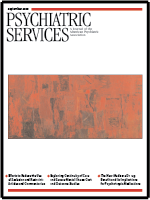Special Section on Seclusion and Restraint: Pennsylvania State Hospital System's Seclusion and Restraint Reduction Program
Abstract
OBJECTIVES: This study examined the use of seclusion and mechanical restraint from 1990 to 2000 and the rate of staff injuries from patient assaults from 1998 to 2000 in a state hospital system. METHODS: Records of patients older than 18 years who were civilly committed to one of the nine state hospitals in Pennsylvania were included in the analyses. Two databases were used in each of the nine hospitals: one identified date, time, duration, and justification for each episode of seclusion or restraint and the other identified when a patient was hospitalized and the demographic characteristics and the diagnosis of the patient. Rate and duration of seclusion and restraint were calculated. Reports from compensation claims were used to determine staff injuries from patient assaults. RESULTS: The rate and duration of seclusion and mechanical restraint decreased dramatically during this period. From 1990 to 2000, the rate of seclusion decreased from 4.2 to .3 episodes per 1,000 patient-days. The average duration of seclusion decreased from 10.8 to 1.3 hours. The rate of restraint decreased from 3.5 to 1.2 episodes per 1,000 patient-days. The average duration of restraint decreased from 11.9 to 1.9 hours. Patients from racial or ethnic minority groups had a higher rate and longer duration of seclusion than whites. Seclusion tended to be less likely, but longer, during the night shift. Patients were restrained less often during the night shift, but for a longer duration. The rate of restraint was higher during the week than during weekends and holidays. Younger patients were more likely to be secluded and restrained, but older patients remained secluded and restrained longer. No significant changes were seen in rates of staff injuries from 1998 to 2000. CONCLUSIONS: Many factors contributed to the success of this effort, including advocacy efforts, state policy change, improved patient-staff ratios, response teams, and second-generation antipsychotics.



